Show 249: Listening Guide
From the Top’s broadcast for Show 249 was taped in was taped in The Palladium at The Center for the Performing Arts in Carmel, IN on Wednesday, March 21, 2012. We asked our performers to tell us about the music they performed on the show:
Nathan Meltzer, violin, 11
Hejre Kati, Scènes de la csárda, No. 4, Op. 32
By: Jenö Hubay
This is a Hungarian gypsy piece, and I really like gypsy music. Maybe it is because I grew up in Vienna across from a tavern, where every night I heard a violin and an accordion playing this kind of music. I try to play the piece like I imagine it would be played in 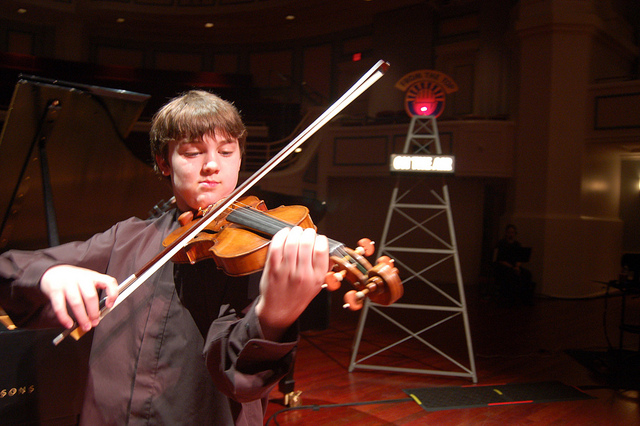 that tavern. It has a really juicy opening. At a master class, Vadim Gluzman told me to not rush any note. He suggested I imagine a one-hundred-year-old man thinking about the love of his life, trying to hold onto every moment of his time with her. Since I’ve never really felt like that yet, I had better luck picturing a band of gypsies reflecting back on a hard day. In the next part, where there are light and soft double stops, I picture bandits sneaking into the gypsy camp. Then the theme returns; it is quieter and slower, because the gypsies are exhausted after the chase. Finally the music turns light and happy again. The bandits are gone, and it’s time to dance!
that tavern. It has a really juicy opening. At a master class, Vadim Gluzman told me to not rush any note. He suggested I imagine a one-hundred-year-old man thinking about the love of his life, trying to hold onto every moment of his time with her. Since I’ve never really felt like that yet, I had better luck picturing a band of gypsies reflecting back on a hard day. In the next part, where there are light and soft double stops, I picture bandits sneaking into the gypsy camp. Then the theme returns; it is quieter and slower, because the gypsies are exhausted after the chase. Finally the music turns light and happy again. The bandits are gone, and it’s time to dance!
As with Zigeunerweisen (by Pablo de Sarasate) and other gypsy pieces I’ve played, I like having the freedom to play around with the interpretation. I also like how I’m able to slack off on some proper shifting techniques and have some very romantic shifts and slides. What I kind of like and kind of don’t like about the piece is that every section is really unique and has its own challenge (style, character, technique). I have to practice every part of it with a very different focus. In the opening, there is a lot of repetition, and the challenge is to make each repetition a little different so it stays interesting. In the fast, dancing part of the piece, I have to work to get the bow articulation right. But it is a really a fun piece to learn and play.
Post Show Reflections: I liked everything, from the pizza party to the outreach programs. I really enjoyed myself! I especially liked hanging out backstage during the show. I also really liked all the people I met. They were not only great musicians but great people. Before I went on stage, I was very nervous. But after Tim and everybody did their comedy acts, I felt better. While I was playing, I felt like I could just go for it because we had already recorded it earlier that day. During the interview, the audience was very encouraging, so I felt like I belonged up there.
I believe that music has the power to make people cry/ laugh/etc. It is a way to communicate what you can’t say.
Tyler Rhodes, guitar, 18
Spanish Dance No.5, “Andaluza”
By: Enrique Granados
To me, this piece of music is very deep. I actually do imagine stories and images when I play. For this piece, I love picturing a middle-aged man complaining about his pathetic love life.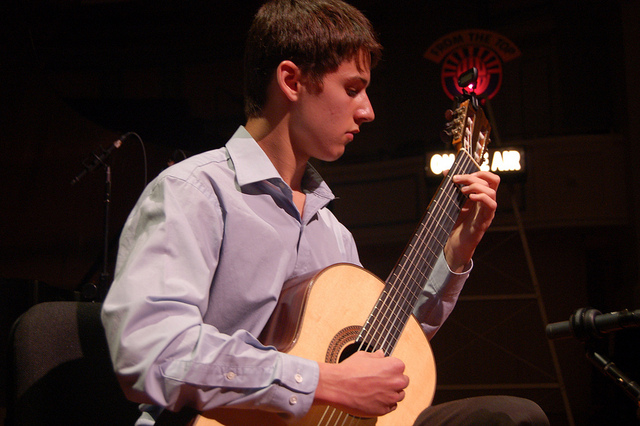
What I like about Spanish Dance No. 5 is that it’s very listener friendly. The musical phrases aren’t too difficult to express, so I can just relax a bit and enjoy it.
Post Show Reflections: My favorite memory was hanging out backstage during the show; a lot of interesting things went down. People never got tired of my sock-hands and we formed Captain Planet with our metals! Well, the concert was a harder performance than I’m used to since I was being recorded. But it felt great to play in such a beautiful space and try to let go!
Music has the power to emotionally connect to others on a whole other level. It impacts people in great and inspiring ways.
Sydney Lee, cello, 15
Introduction & Polonaise Brillante, Op. 3
By: Frédéric Chopin
Chopin’s Polonaise Brillante is one of his earliest compositions. He composed this piece at the age of 19. It’s a showy, fantastic piece in the “happy” key of C major that is a lot of fun to play. What makes it so brilliant are the virtuostic ornamentations, wide 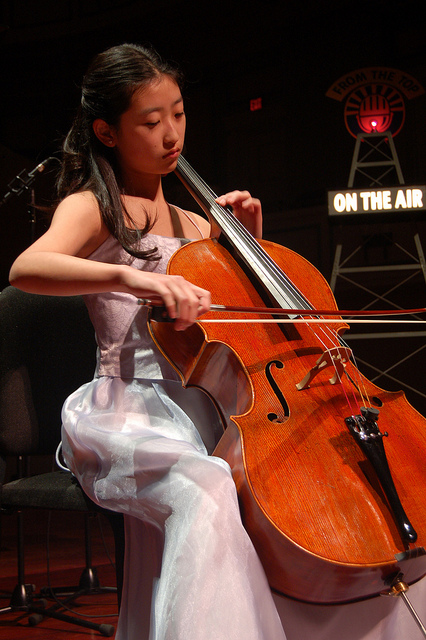 jumps, arpeggios, and fast runs. When playing the fast runs, it is crucial that the cellist mimics the pianist’s smooth, continuous motion. Although they are technical, fast runs, Chopin presented it in a way that would show off the effortless gliding of the musicians’ fingers. Also, there are lyrical, singing sections that are charming and somewhat youthfully innocent. This all requires me to be daring, but it is so much fun to go out of my “comfort zone” and play around with the different characters. This piece is exhilerating to the very end!
jumps, arpeggios, and fast runs. When playing the fast runs, it is crucial that the cellist mimics the pianist’s smooth, continuous motion. Although they are technical, fast runs, Chopin presented it in a way that would show off the effortless gliding of the musicians’ fingers. Also, there are lyrical, singing sections that are charming and somewhat youthfully innocent. This all requires me to be daring, but it is so much fun to go out of my “comfort zone” and play around with the different characters. This piece is exhilerating to the very end!
Post Show Reflections: I had a blast! It was great making new friends from all over the country. We bonded quickly through our common love of music. The supportive atmosphere of the FTT staff made it so easy for us to enjoy the performances. I feel so priliveged to have played in the gorgeous Palladium. I loved sounding so big and being under the spotlight. It was like being on top of the world!
Music is the universal language. The listener is able to connect with the performer through feelings and emotions. Music has the power to touch, change, and heal the heart. Ultimately, it can change lives.
Quartet Tzigane.
IV. Allegro Molto from Piano Quartet in D minor
By: William Walton
Graydon Tope, violin, 15
This piece is a mix of many composers that Walton listened to before he started composing. When I listen to the piece, I listen to all the different sections and try to distinguish the composers that I know whose rhythms inspired Walton in his piano quartet. Out of the multiple sections, there are two that I really love. The first is the dissonant section: the notes are powerful because of the dynamic, but also because the instruments clash. It reminds me of a person dragging their nails over a chalkboard – pleasant, 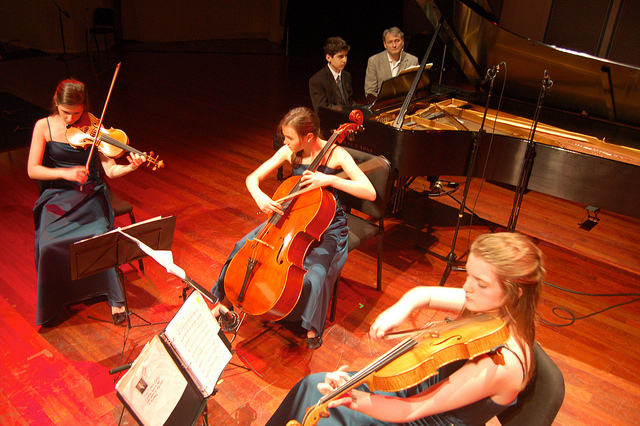 right? The other section that is fun for me is the viola solo, or that general section after the eighth note passages: this passage is tranquil, it even calms me in the performances! It reminds me of a Winslow Homer painting. Many of his paintings are of boats on the ocean, but the one that I picture in my heard is the one with two men and a sexton. It looks stormy, but it also seems quite calm, like a lull in a storm. The first time that we recorded this piece, we all played it super slow, so we sounded like elephants on the Serengeti. We were laughing each time we made a mistake and Tom kept telling us to go faster. We never made it to the end we were laughing so hard! In addition to that, whenever we rehearse, Parker always says “Four!” when we end the piece. We all just smile because we all know that it is supposed to be “one.” Parker, I think, just does it intentionally to make the rehearsal more fun.
right? The other section that is fun for me is the viola solo, or that general section after the eighth note passages: this passage is tranquil, it even calms me in the performances! It reminds me of a Winslow Homer painting. Many of his paintings are of boats on the ocean, but the one that I picture in my heard is the one with two men and a sexton. It looks stormy, but it also seems quite calm, like a lull in a storm. The first time that we recorded this piece, we all played it super slow, so we sounded like elephants on the Serengeti. We were laughing each time we made a mistake and Tom kept telling us to go faster. We never made it to the end we were laughing so hard! In addition to that, whenever we rehearse, Parker always says “Four!” when we end the piece. We all just smile because we all know that it is supposed to be “one.” Parker, I think, just does it intentionally to make the rehearsal more fun.
The Walton, again, is full of different styles from different composers (Gershwin, Stravinsky, Debussy, Ravel) that Walton listened to. There are many different aspects of each section that need to be accentuated when playing this piece, most importantly, the dynamics. They are what make all pieces go round but particularly for this piece, they are the most important. We try to get the dynamics, and movement, to express the emotions. The most difficult part of this piece is the intonation. There are many key changes and passages that are full of notes that are very abstract and are harmonized in a unique way with the other instruments. So, we all have difficulty matching each other tone wise, but I think we make up for that by having fun on stage, as much as intonation is important to the portrayal of the piece. Of the many chamber music pieces that I have performed, this was definitely a challenging piece to put together as a group, but I have learned so much from it because of all the composers that Walton tried to incorporate, as well as himself, in this wonderful piece. This piece captured our hearts from the moment we listened to it and it is one of the most awesome pieces I have ever played!
Post Show Reflections: My favorite moments were playing on stage and bowing with everyone, knowing that we had all accomplished a once in a lifetime opportunity. For the actual concert, my heart was beating and yet, I was clam and composed. It was fun being up on stage giving music to the people to listen to, as well as bowing to thank them at the end. It was the greatest and most positive experience ever!
Music can change yourself and other people. You learn so much from music that changes who you are every day. Playing for other people, I think, will always change your life: sharing music is one of the most powerful forms of art that has even been created. It isn’t even an art form. It is who you are.
Sloane Wesloh, viola, 15
This piece is INTENSE! Graydon described it as hormonal, like a teenager. It is scary, sweet, slow, fast, sad, happy, major, minor – you name it. Walton wrote it when he was 16, so I feel like we can relate to it really well. Despite the intensity of the piece, we end up grinning sometimes because it’s just so much fun to perform. Before performing the Walton, I get really excited rather than nervous. Backstage, I am completely psyched to introduce it and all of its energy and passion to the audience.
We really have to sell this piece. It’s not Haydn or Mozart- people aren’t used to Walton. It has to sound polished for the audience to enjoy it. It’s easy to play this piece in an out of control and crazy way, but we have to focus on staying in control of the piece for it to sound polished. That’s really difficult for us to do because we tend to be a very energetic group- it’s easy for us to get out of control! Focusing on staying in control- while still having fun and staying free- is very important for our quartet.
Post Show Reflections: I loved just being around everyone and being inspired. Everyone was a true musician and they were all wonderful people, musicians, and staff. The arts leadership orientation was SUPER FUN and I liked how it went beyond just an information session, it was about getting to know yourself. It was very fun. The Palladium is GORGEOUS. It was such an honor and privilege to have the opportunity to perform there (and on From the Top in general). I am so lucky that I got to perform in such a beautiful hall with my quartet family – we could not stop grinning at the end, we were just completely pumped!
Music has the power to change lives, build hope inspire anyone and empower everyone. It is truly magical.
Parker Tope, cello, 13
Quartet Tzigane researched William Walton on Wikipedia and read all about him. The only fact I can remember about Walton is that he was an ambulance driver (and a bad one, as he said himself). Whenever I am playing, the hectic, yet organized chaos  reminds me of an ambulance and the driving issues Walton must have faced. My favorite part is when we are playing the section of insane and refreshing dissonance: all of us have a great time and have big fat grins across our faces because of how cool the music sounds. The first time we played the Walton in the recording studio; we had only just begun learning it and had only practiced maybe the first page. We decided to fool around and record the Walton, Tom kept saying “go faster!” and pushing us through the piece. In the beginning of the piece, you can hear me whooping in encouragement while we are playing and Sloane giggling and chortling. After an extended period of hilarious failure, Graydon is yelling out measure numbers of where we should start again. Evren was just playing really well and sometimes making up a bunch of notes as we get the recapitulation. I had the time of my life.
reminds me of an ambulance and the driving issues Walton must have faced. My favorite part is when we are playing the section of insane and refreshing dissonance: all of us have a great time and have big fat grins across our faces because of how cool the music sounds. The first time we played the Walton in the recording studio; we had only just begun learning it and had only practiced maybe the first page. We decided to fool around and record the Walton, Tom kept saying “go faster!” and pushing us through the piece. In the beginning of the piece, you can hear me whooping in encouragement while we are playing and Sloane giggling and chortling. After an extended period of hilarious failure, Graydon is yelling out measure numbers of where we should start again. Evren was just playing really well and sometimes making up a bunch of notes as we get the recapitulation. I had the time of my life.
I have never played a piece more bold or audacious. I feel that the most important thing to do while playing this piece is to live and play on the edge; it makes you and the audience feel exhilarated. Even after ending piece, I can still feel the adrenaline pumping through me. The hardest part of the piece is playing together and yet with intensity. You feel the need to push ahead and go totally crazy. To play with maturity with this amazing piece of music is incredibly hard.
Post Show Reflections: Right before everyone went on stage we had a pow-wow and just laughed and had a great time. After the concert everyone was so happy and the whole entire experience bonded all of the performers. I have never experienced anything more spectacular. The Palladium is beautiful; it was an honor to play on the stage with From the Top. All of the producers were so helpful so every step of the process was easily accomplished. It was such a fun and memorable experience. It was so awesome to be able to play on From the Top; it has always been a dream of mine.
When playing music on stage, my goal is always to take care of the audience and to have everyone have a great time. By sharing music and the joy of the arts, you have the power to bring together communities and different groups of people. Music is like love; it is a universal language that will never die and that is understood by everyone.
Evren Ozel, piano, 13
I think the Walton is a piece that is very well fit for teenagers: it’s moody. Venturing from colossal parts where you want to plug your ears because of the ugly harmonies, to beautiful solos that you wish you could hear more of, Walton wrote this piece when he was 16, a little older than we are. The first time we played this piece together in our studio was a nightmare.
There are infinitely many ways for this piece to be performed, and deciding on one specific way is difficult. Technically, the most challenging part of the piece is keeping the tempo, the rhythm, and how to stay together. Luckily, we haven’t had too many problems with piece yet…
Post Show Reflections: My favorite memory from the three days was the show night, where everybody was so supportive of each other backstage. We talked to each other about random things, but it just was so much fun. I always felt like performing was fun, but I never knew it could be that fun. I loved the feeling in my gut when I went on stage. It was a nervous but relaxed adrenaline, if that makes any sense.
Music has a life of its own. It can communicate, show emotion, make friends, and much more.
Evelyn Mo, piano, 13
L’isle joyeuse
By: Claude Debussy
This piece is one of my favorite pieces. When I play it, I imagine people dressed in velvet embarking on a happy journey to Cythera, the island of joy. It’s also full of mystery – what’s on the other side of the water? What’s at the bottom of the hill? My favorite part has to be the end: it’s rich, luscious chords are full of triumph and really sum up the whole piece. When I play this piece, I just have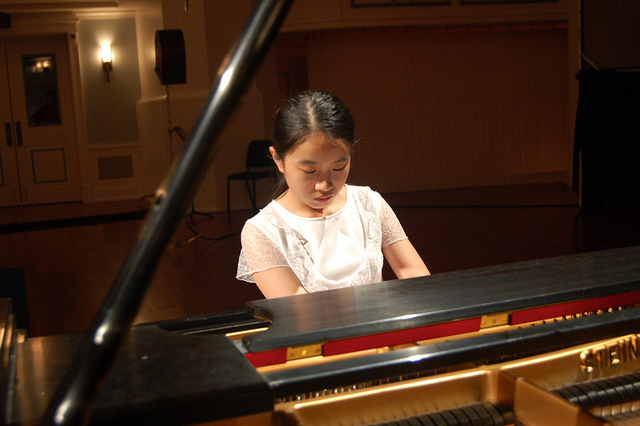 fun and let loose all my excitement and energy. After all, if I have a good time, so will my audience.
fun and let loose all my excitement and energy. After all, if I have a good time, so will my audience.
I think this piece is the most joyful and exuberant piece I’ve ever played. The most important thing is conveying the built-up excitement to my audience and painting each phrase with a different color. While nailing all the technical passages and rhythms is tricky. I would have to say that hitting the very last note, and not the wood of the piano, is the biggest challenge.
Post Show Reflections: My favorite moments were in the Green Room right before the taping. There was lots of good food and it was a lot of fun because everyone was so supportive, talkative, relaxed and funny. The performance was incredible. The Palladium was huge, and the acoustics and the piano were amazing. The audience was very warm and welcoming, so I didn’t ever feel very nervous at all.
I believe music has the power to do everything: invoke excitement, warm the heart, soothe the soul, calm the mind, bring tears, and even stir anger. It brings people together and expresses in ways no words can.



